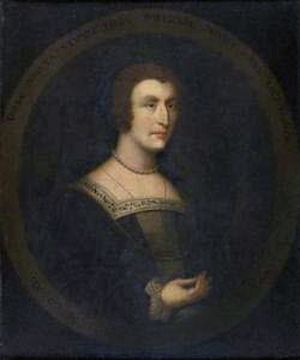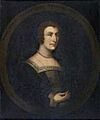Janet Stewart, Lady Fleming facts for kids
Quick facts for kids
Janet Stewart, Lady Fleming
|
|
|---|---|
| Lady Fleming | |

Portrait of Lady Janet Stewart by George Jamesone
|
|
| Full name |
Janet Stewart
|
| Born | 17 July 1502 |
| Died | 20 February 1562 |
| Noble family | House of Stuart |
| Spouse(s) | Malcolm Fleming, 3rd Lord Fleming |
| Issue | Johanna Janet Margaret Fleming, Countess of Atholl James Fleming, 4th Lord Fleming Elizabeth John Fleming, 5th Lord Fleming Agnes Mary Fleming Henri d'Angoulême |
| Father | James IV of Scotland |
| Mother | Agnes Stewart |
Janet Stewart, Lady Fleming (born 17 July 1502 – died 20 February 1562) was a Scottish noblewoman. She was known in France as la Belle Écossaise, which means 'the Beautiful Scotswoman'. Janet was a daughter of King James IV of Scotland, born outside of marriage.
She later became the governess (a kind of tutor and caretaker) for her young half-niece, Mary, Queen of Scots. For a short time, Janet also had a relationship with King Henry II of France. They had a son together, Henri d'Angoulême, who was later officially recognized as a royal child. Janet's own daughter, Mary Fleming, was one of Queen Mary's famous "Four Marys", who were her close companions.
Contents
Janet Stewart's Family Background
Janet Stewart was one of several children of King James IV of Scotland. She was the fifth of his children born outside of marriage to live to adulthood. Her half-brothers included James Stewart, Alexander Stewart, and James V. James V was her father's only child born within marriage who survived.
Janet's mother was Agnes Stewart. Agnes was the daughter of James Stewart, 1st Earl of Buchan. Janet's parents were distant relatives.
Marriage and Children
Janet Stewart married Malcolm Fleming, 3rd Lord Fleming. They were related in a way that was usually not allowed for marriage at the time. Despite this, they had eight children together:
- Lady Jean Fleming (born 1520)
- Johanna (born 1525)
- Janet (born 1527)
- Margaret Fleming (born by 1532)
- James Fleming, 4th Lord Fleming (born around 1534)
- Elizabeth (born 1530)
- John Fleming, 5th Lord Fleming (born around 1535)
- Agnes (born 1535)
- Mary Fleming (born 1543)
Margaret Fleming, one of Janet's daughters, was sometimes said to have special powers. Her daughter Mary Fleming became one of the "Four Marys" who served Mary, Queen of Scots.
Life at Court
Janet's husband, Lord Fleming, died in battle in 1547. The next year, because she was connected to the royal Stewart family, Janet was chosen for an important role. She became the governess for her infant half-niece, Mary, Queen of Scots. Mary was the daughter of Janet's late half-brother, King James V. Janet's own daughter, Mary Fleming, also joined the queen's royal household as a lady-in-waiting.
In August 1548, Janet and her daughter traveled with the young Queen Mary to France. They waited on a ship on the Clyde near Dumbarton Castle. Janet asked if the queen could go back to shore to rest. But the ship's captain, Nicolas Durand de Villegaignon, insisted they would go to France.
A scholar named Giovanni Ferrerio worried that Lady Fleming only spoke Scots, not French or Latin. He thought she might not be able to tell French doctors if Queen Mary became ill. He hoped a Scottish doctor would be appointed instead.
Relationship with the French King
At the French royal court, Lady Fleming soon caught the eye of King Henry II of France. They began a relationship, and Janet became pregnant. After having a son with the French king, Janet was sent back to Scotland. Another woman, Françoise de Paroy, took her place as Queen Mary's governess.
Janet's son with King Henry II was named Henri de Valois-Angoulême (born 1551 – died 1586). He was considered the king's most favored son born outside of marriage. Henri was later officially recognized by the king. He grew up to hold important positions in France, like Governor of Provence.
In November 1549, Janet's son James, Lord Fleming, who had been captured in a war, was released. In October 1552, Mary of Guise, Queen Mary's mother, wrote about Janet's situation in Scotland. There was talk of Janet marrying Henri Cleutin, a military advisor. Mary of Guise knew Janet wanted to see King Henry II again. However, Mary of Guise told her brother that Janet would not be leaving Scotland.
In June 1560, Janet was one of the women who stayed with the body of Mary of Guise at Edinburgh Castle. The women were not given mourning clothes at first. Janet quoted a Latin phrase to an English diplomat, meaning "Rend your heart, not your garments." Later, on 22 August 1560, Janet asked for permission to leave Scotland with her son, Henri de Valois. Henri later took part in a violent event called the St. Bartholomew's Day massacre. He died in a duel in 1586.
Images for kids


